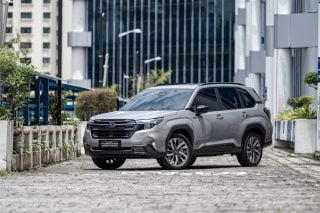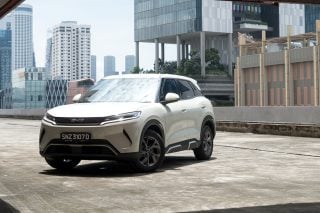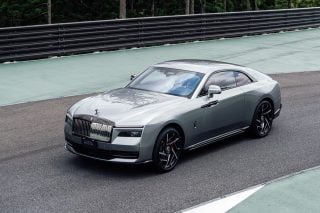
GLC300e 4Matic AMG Line.
Going electric seems like the logical thing to do, since everyone says that all cars will eventually be electric. EVs are quieter, more responsive and less pollutive. Besides, with more charging stations being built, that means more convenience for drivers.
But there are still hurdles to EV adoption. Not every building has charging points. Each charging provider has its own app, which means numerous apps to download. And charging takes longer than pumping petrol.
What about a hybrid then? A hybrid seems like a better choice since you don’t have to deal with these issues, right? But then again, the smoothness of an EV and the fact that it’s “the future” is still more enticing. Electric or hybrid? Oh, how does one decide?

THE BEST OF BOTH WORLDS
Perhaps this conundrum is what Mercedes’ GLC300e aims to solve. The all-new mid-size SUV is a plug-in hybrid (PHEV), and this powertrain could be what pleases fence-sitters.
For the uninitiated (and undecided), a plug-in hybrid has an internal combustion engine and an electric motor, which is fed by a battery.
Compared to a regular hybrid, a PHEV has a larger battery and more powerful electric motor. This enables it to travel faster and further on electric power alone.

And as its name states, you can recharge the battery by plugging the car into an AC or DC charging station. Ah, but this is optional. If you don’t feel like charging the car, the internal combustion engine lets you continue driving even with the battery depleted.
Said engine is a turbocharged 2-litre 4-cylinder producing 201hp and 320Nm of torque. Working alongside it is an electric motor with 134hp and 440Nm of torque, which is fed by a 31.2kWh lithium-ion battery.
Now, we can’t just add all the numbers to derive the total output, as the electric motor and engine produce these figures at different points. But with a combined system output of 308hp and 550Nm of torque, there’s ample muscle to move the 2355kg SUV.

B mode tells the car to hold the battery’s current charge level, but it would have been better if you could pre-set the percentage.
MODES TO MATCH MOODS
Indeed, the GLC300e’s mass isn’t as obvious as expected because of the electric motor, which by the way, handles most of the propulsion. Get behind the wheel and press the ‘Start’ button and nothing seems to happen because the engine remains sound asleep.
With the battery at around 90%, the trip computer predicted an electric range of 100km. Mercedes claims a 138km range with a full charge.
The GLC300e’s default drive mode is E or Electric, but slam the accelerator pedal halfway down and the engine wakes up. Even in Hybrid mode, the engine only joins the party when you really demand extra muscle.
And when it does wake up, it’s quieter than expected, and better still, doesn’t sound as agricultural as other Mercedes four-cylinder units. Its power comes on smoothly, too, so you don’t end up feeling a sudden shove.

The MBUX system includes an off-road specific display, even if most GLC300e owners only drive on-road.
In Hybrid mode, I managed up to 35.7km/L over two days of driving in mixed conditions. My “worst” figure was 30.3km/L. However, since the electric motor does most of the heavy lifting, the batteries had less than 20km left by then.
I could have continued driving without charging by activating B or Battery mode, which tells the car to hold the current charge level. Unfortunately, this means that the engine will keep running and thus burn more fuel, which goes against the purpose of the GLC300e.
My guilty pleasure was driving the GLC300e in S or Sport, which configures the powertrain for maximum response. With the SUV at its perkiest, it’s hard to resist stabbing the accelerator pedal and getting pulled forward at a rapid pace.
Zero to 100km/h happens in 6.7 seconds, which is respectable. However, that’s half a second slower than the less powerful GLC300. Weight is to blame here, for the GLC300e weighs a hefty 430kg more than its sibling. That’s the equivalent of five 80kg adults plus their shopping.

Pliant damping and quiet ride are nice, so the relatively quick steering was a surprise.
EASY-GOING COMPANION
That said, the GLC300e fulfils its purpose as a luxury runabout with eco-friendly credentials. If comfort is at the top of your list, you’ll find it in this Merc’s gentle ride, smooth manners and quiet performance.
You need to avoid sudden braking manoeuvres, though, for this is when the car’s need for longer stopping distances becomes obvious.
Dynamics aside, the latest GLC’s interior should please Mercedes fans. Compared to the previous model, there’s more room for the driver’s left foot, and the cabin’s materials (except for the visors) are all softer and of a higher quality.

The GLC’s cockpit feels better built and more upmarket compared to the preceding model’s.
Mercedes-Benz really has a flair for ambient lighting, and they have showcased it again here. The carmaker’s MBUX 2.0 (Mercedes-Benz User Experience) is also more user-friendly than BMW’s latest OS 8, so even first-timers will find the system to be intuitive.
With the GLC’s wheelbase 15mm longer than before, there’s a bit more space for rear occupants as well. The tall backrests enhance comfort, especially for passengers taller than 1.75m, although the middle occupant must still contend with a floor protrusion.
The larger body has also improved the GLC’s practicality, with boot capacity growing from 550 litres to 620 litres. However, in the GLC300e, the plug-in hybrid components reduce the cargo volume to 470 litres.

TAKING IT ALL
A regular turbocharged powertrain seems boring, but when you think about hybrids, you conclude that they don’t go far enough. Yet you also remain sceptical about owning an EV.
The GLC300e might be what you’re looking for in this case. It offers the seamlessness of an EV, greater efficiency than a hybrid, and more power than a normal turbocharged engine. All this, without the absolute need to charge the battery.
The best analogy is this: You’re going on a five-day tropical holiday but can’t decide if you should also bring jackets in case it rains. You’re also wondering if you should have formal evening wear along with your resort outfits, because you know, just in case.
So, you decide to pack everything and end up travelling with three large suitcases. That’s what the GLC300e is about. And if you get it, you won’t be a fence-sitter for much longer.
This article was first published in Sgcarmart.
Mercedes-Benz GLC300e 4Matic AMG Line 2.0 (A)
ENGINE 1999cc, inline-4, 16-valves, turbocharged, plug-in hybrid
COMBINED SYSTEM POWER 308hp
COMBINED SYSTEM TORQUE 550Nm
POWER TO WEIGHT 130.8hp per tonne
GEARBOX 9-speed automatic with manual select
0-100KM/H 6.7 seconds
TOP SPEED 218km/h (140km/h electric only)
CONSUMPTION 166.7km/L to 200km/L (combined)
PRICE INCL. COE From $415,888
AGENT Cycle & Carriage Industries
What is the difference between a hybrid, plug-in hybrid and electric car?




















































